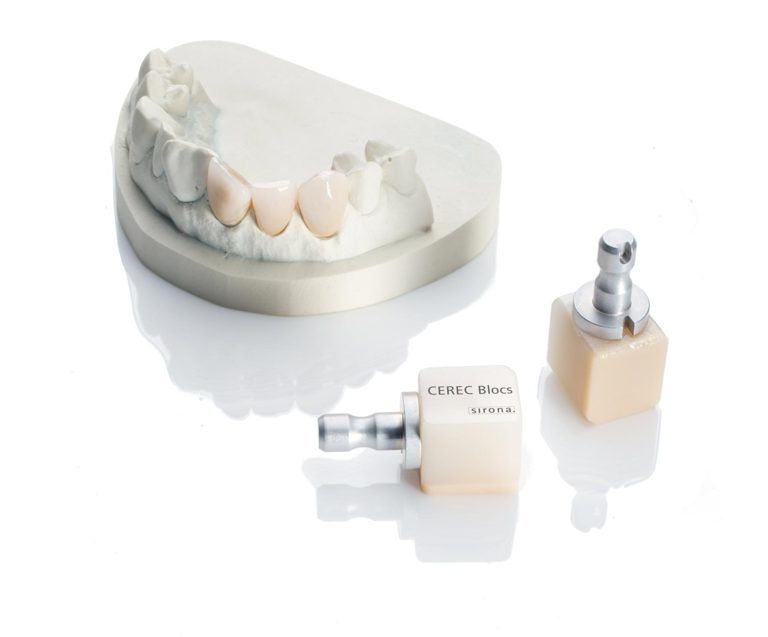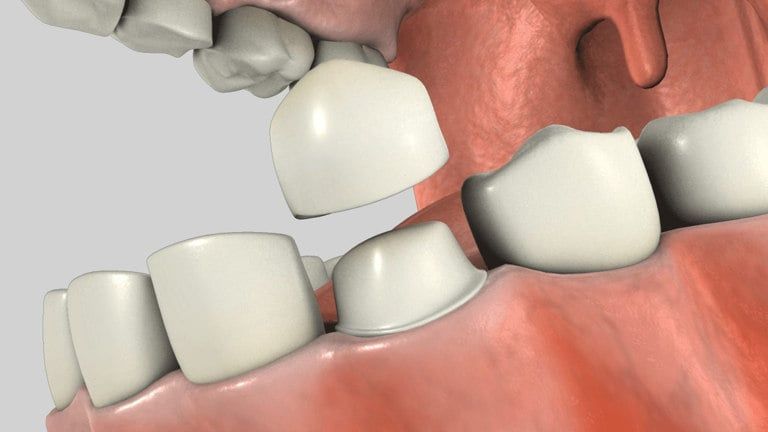Crowns
Crown Procedure
A crown is sometimes termed a "cap" or "jacket." A crown will restore a large filling or a cracked tooth to its original size, shape and tooth color. A crown may be recommended after root canal therapy has been completed, as the tooth tends to become brittle and is more likely to fracture. A crown can strengthen and protect the remaining tooth structure and improves the appearance of your teeth. With the advances in technology, we now have the ability to make ceramic crowns with no metal.
To place a crown, your dentist must reduce 1-2 mm of the tooth to make room for it. Your dentist will then use a piece of thread or cord or use a laser to push the gum down around the tooth, to take an impression of the tooth. The impressions are sent to the lab where the crown is made. During that time, you will have a temporary crown. These crowns are usually made of plastic and are made in your dentist's office on the day of your visit. They are not meant to last. If a temporary crown is left in the mouth, the cement eventually washes out and the tooth can decay. At a second visit, your dentist will remove the temporary crown and test the permanent one. Sometimes crowns need additional polishing, glaze or some other adjustment before they are placed. Once the crown is ready, it's cemented to your tooth.
Crown Aesthetics
If your smile is in need of a makeover, crowns can provide predictable results. Crowns can give an unattractive tooth back its beautiful shape and color. For smaller or worn down teeth, a crown can restore the natural size of the old tooth. A crown can replace either part of or the tooth's entire structure. For procedures requiring only the areas visible from the outside, a veneer may be an alternative option.
CEREC to the Rescue to Provide Same-Day Dentistry
Our patients benefit from single-visit restorations including crowns, inlays & onlays, white fillings and veneers using a very high-tech piece of dental equipment called CEREC.
CEREC stands for CEramic REConstruction and represents a process where we digitally scan the area of your mouth where the dental restoration will be placed, designing a replacement restoration right there, and finally milling the final restoration during the same appointment.
Our patients don't have to walk around with bulky and uncomfortable temporary crowns and won't have to come back for a second appointment for the final fitment and placement of the dental restoration. If you are in need of a dental restoration, chances are CEREC can provide it in just one visit. We invite you to call our dental office at (916) 365-9262 or request an appointment online and let us answer that question right then and there!

Placing a Porcelain Crown In 1 Visit
Because our office can provide a dental crown in a single dental appointment, we do things a little different than other dental offices. We can skip the temporary molds and the time it takes to have a dental lab fabricate your final crown.

1. We start the crown procedure by reducing the overall size of the tooth that's in need of a dental crown. Shaving off existing tooth structure allows for the new crown to fit properly and it also creates a foundation for the new crown to be bonded to.

2. Next, using our state-of-the-art CEramic REConstruction (CEREC) system, we will digitally scan the section of your mouth that has been prepared for the crown. This is done by using a special wand that can be easily positioned in your mouth to ensure an extremely accurate digital representation of the restoration area.

3. We will now be able to see a high-resolution 3D representation of the area and start to design a new crown that will fit perfectly over the prepared tooth. Our patients often love getting to see us create a new tooth for them in real time, right there on the screen.

4. Once the digital representation of the new crown has been created on the computer, we will send it off to our in-house milling machine. We place a block of porcelain that has been color-matched to the shade of your existing tooth into the milling machine and run the program. This amazing machine robotically fabricates a perfect crown restoration that is ready to be placed over the prepared tooth at this time. This crown is the final crown and NOT a temporary crown which means you have just received a new dental crown in a single dental appointment.
Full Porcelain Crowns
These are very aesthetic, bonded crowns. They are mostly used for front teeth because they are the most natural looking type of crown and are often used in "cosmetic" dentistry.
There are many types, but they all have a common feature - no metal. They can occasionally break, but dental technology has advanced far enough to make them quite strong.

Gold Crown
The 'gold' standard. Dental gold is about 60% gold alloy which is meant to match the hardness of the enamel of opposing teeth so both wear about evenly, an important trait. Gold does not tarnish or corrode and has some bacterial-inhibiting quality. Gold crowns are strong and will not break. However, gold crowns obviously are not considered aesthetic; they are gold colored. Usually, gold crowns are used for lower back molars because they aren't as noticeable.

Porcelain Fused To Metal Crown (PFM)
The most common type of crown and has a proven track record. PFM crowns are fairly aesthetic and they look like real teeth. However, the margins or borders may appear dark because PFM crowns have a metal substructure with layers of porcelain fired over the substructure. Porcelain is very hard, much harder than natural enamel and may cause excessive wear of the enamel of opposing teeth. Porcelain may break with extreme biting forces.
Types of Crowns
With today's advances in dentistry, there are several options when choosing a type of crown:
- Porcelain outer surface with a metal base crown
- Pure porcelain or composite crown
- All metal crown, which is usually gold
They all differ in durability, strength, appearance and cost.
